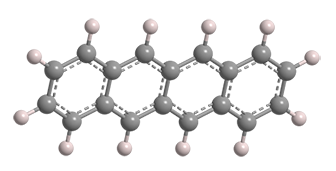What molecule am I?


Tetracene is a four-ring polynuclear (i.e., polycyclic) aromatic hydrocarbon (PAH). It is the second member of the “acene” family of linearly arranged PAHs that begins with anthracene and continues to pentacene, hexacene, and beyond. The bright orange molecule is also known as naphthacene, 2,3-benzanthracene, and benz[b]anthracene.
Unlike many PAHs, tetracene is not carcinogenic. But it was studied for carcinogenicity as long ago as the 1930s. Early researchers were James W. Cook and co-workers at the Cancer Hospital of London and Alfred Winterstein and Karl Schön at the Kaiser Wilhelm Institute for Medical Research1 (Heidelberg, Germany).
Not much was done with tetracene until 2007, when researchers discovered that it is a semiconductor that was useful in organic field-effect transistors (OFETs) and organic light-emitting diodes (OLEDs). This year, electrical engineer Marc A. Baldo at MIT (Cambridge, MA) and colleagues there and at Princeton University (NJ) incorporated it into silicon solar cells (SSCs).
The maximum efficiency (conversion of sunlight into useful electricity) of single-layer SSCs is currently 29%. When the researchers added the semiconductor tetracene to SSCs, the cells’ efficiency increased to 35%. Through a complex process involving the emission of excitons from tetracene, the SSCs’ wavelength range widened, making the cells more efficient.
Other solar cell researchers consider the Baldo team’s findings to be a major breakthrough and intend to follow it up by incorporating them in their own research.
1. Now the Max Planck Institute for Medical Research.
Tetracene hazard information
| GHS classification*: not a hazardous substance or mixture |
*Globally Harmonized System of Classification and Labeling of Chemicals.
Tetracene fast facts
| CAS Reg. No. | 92-24-0 |
| Empirical formula | C18H12 |
| Molar mass | 228.29 g/mol |
| Appearance | Yellow-orange to red-orange crystals or powder |
| Melting point | 357 ºC |
| Water solubility | Insoluble |

Learn more about this molecule from CAS, the most authoritative and comprehensive source for chemical information.
Molecule of the Week needs your suggestions!
If your favorite molecule is not in our archive, please send us a message. The molecule can be notable for its current or historical importance or for any quirky reason. Thank you!
Stay Ahead of the Chemistry Curve
Learn how ACS can help you stay ahead in the world of chemistry.

